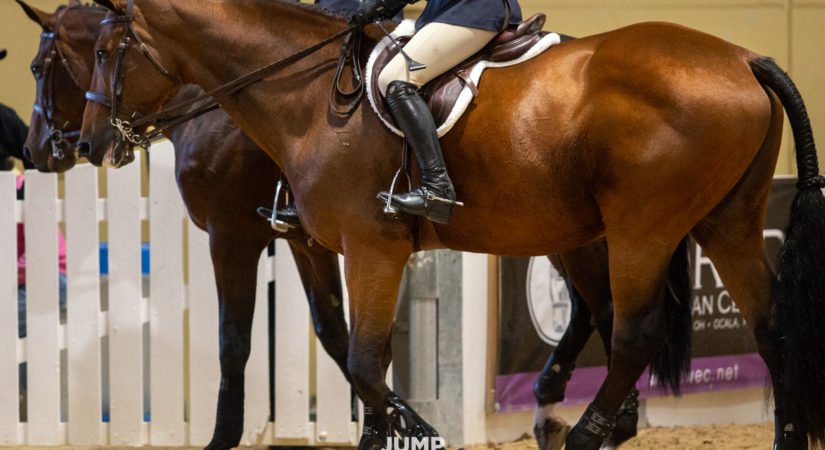Equitation classes in the United States are often used as stepping stones to the upper levels of hunter and jumper competition. Yet, as a spectator at some of the 2022 year-end equitation championships, I was struck by how far the sport has deviated from its origins and how our horses are paying the price. As we head into a key qualifying season for these events, I am raising the issue with the hope that we can do better at this year’s equitation finals and beyond.
The Origin Of Equitation
Hunter seat equitation has roots in foxhunting, which was never a sport for the frail of body or faint of heart. Riders needed strong seats, balance and grit to navigate the terrain, roads and fences of a hunt field. As the competitive sport of jumping gained popularity in the United States, hunter seat equitation was eventually introduced to reward riders who embrace the attributes found in foxhunters.
Over time, equitation also adopted elements of jumping seat riding, which is what we see in today’s jumper ring. This style of riding is similar to what we’d see in a hunt field but has roots in the cavalry, where riders had to move from the front lines to the rear across ditches, fences and water. Our great coaches Bertalan de Némethy and Jack Le Goff learned to ride in the military and trained our riders to this standard in the 1960s and 1970s. Their goal, similar to developing riders for a hunt field, was to create tougher riders and stronger jumping horses. Riders couldn’t gallop across the field or ride ditches and rails without a strong seat and an ability to direct and react to a horse at a high speed.
As equitation evolved throughout the decades, it took on a blend of hunter seat and jumper seat to become a discipline uniquely its own.
Too Passive
Hunter seat equitation today, however, does not foster the type of assertive riding required for the open field. I am not suggesting a return to the sport of the past, but the sport, as a whole, has become too passive, and the horses are paying the price for it.
An increased number of adults and children are participating at lower levels, and this is generally a good thing. The horse business seems to be growing without limit, but there has to be one. Not all people are capable of safely riding a horse at the level they wish or jumping a horse at the height they desire at any given moment. For some equestrian professionals and trainers, it’s hard to say “no” to a client when a lot of money is on the line. This has resulted in trainers “quieting” the horses down and a lack of variation in courses and fences, so that riders can compete safely in any level of class they want, even if not prepared for it.
The jumper ring does not have this same issue for two reasons: First, jumper tracks present new obstacles at almost every turn and require the ability to swiftly lengthen and shorten a horse’s stride. Because horses aren’t penalized for galloping between fences or displaying freshness such as hopping slightly when changing leads, “blood” and reactivity are desired qualities in a jumping horse. Second, the variations in a jumper course, paired with the need for a quick, careful ride means riders must be savvy and able to properly handle the horse over the track. If a rider attempts to compete in a division that is beyond their capability, problems will crop up on course, and it’s more likely that the rider will step down a level and not move up until they can safely navigate upper-level divisions.
In equitation today, there is very little variation in the height of fences, the striding, the style of obstacles and the track. Quietness and sameness win the day. A hitch in a lead change or the swish of the tail can cause a ribbon to evaporate. Based on how these classes are being pinned, trainers have learned two consequential lessons: First, that an automaton type of performance wins classes and sells horses. Second, that lower-level riders can be more competitive in equitation on a quiet horse. As a result, if the trainer can regulate the horse’s energy level to the point that it won’t buck, it won’t swish its tail, and it won’t speed up when the rider sits deeper in the saddle, then the rider has a shot at earning a ribbon providing all of the fence distances are hit correctly. It’s a success for the rider, owner, trainer and the business—everyone but the horse.
While I accept that the sport must accommodate the business, I cannot accept what some of the horses are subjected to in order to produce the right energy level in the ring. This problem seems most severe in the equitation disciplines, but it’s a problem with the hunters as well, particularly during finals and championship competitions. If your jumper mount is too tired, it won’t react fast enough and will knock down a rail. There is a limit to how far one will exhaust a jumper’s energy. This is not the case with equitation horses; they are wanted dead quiet and not alive. If a trainer wishes to stay competitive with peers, they must produce quiet horses for the ring.
This poses two distinct problems: First, the goal of producing strong, effective riders who can ride the average sport horse gets lost. Second, our horses are paying a physical and mental price for these “reaction-free” rides.
I believe there is a way to improve our riders’ competence and our horses’ welfare at the same time.
Let’s take a look at the problem and see what can be done to level the playing field for all, including the horse.
Risking The Horse’s Well-Being
Of course, there is often cause to school a horse in preparation for the show ring, but there must be a threshold for how much the horse is worked leading up to the class. Physical and psychological stress to the horse must have limits.
Multiple sessions of longing and riding before the event to make the horses tired have become commonplace. It breaks horses down. Acute and chronic injuries, tendon strains and foot problems follow. The need for anti-inflammatory medications has become greater, and many horses can’t get to the ring sound without them.
In addition to physical taxation on the horse, various pastes and exogenous amino acids are administered orally or injected subcutaneously to calm the horse. Beyond exercise and medication, horses are bombarded with therapies like ultrasound and shockwave, partly to alleviate pain from overexertion but also to reduce tension. More harmful and desperate methods to quiet a horse—such as withholding water or drug combinations also exist—all to produce a reaction-free quietness and an unchanging performance.
Proposed Improvements
In December 2022, I was pleased to see the U.S. Hunter Jumper Association propose and pass two rule changes related to the preparation and schooling of horses at shows. These rules now head to U.S. Equestrian Federation’s mid-year board meeting for final approval, and if approved, will go into effect on December 1, 2023, unless otherwise noted.
The first rule requires a number be attached to the horse or to the individual riding, longing or exercising the horse to allow stewards the opportunity to address horse-welfare concerns in a timely manner.
The second rule prohibits longing a horse in an unsafe manner or excessively, such as longing a visibly exhausted horse, galloping on a tight circle, or chasing it with a whip.
The new rules are a step in the right direction, but they are not enough to address the deeper problem affecting equitation horses.
Since the welfare of equitation horses is most concerning at the higher levels of competition, such as at regional and national equitation finals, I’m in favor of applying additional rules and restrictions at these events.
First, adding more pre-competition control, similar to what we see in FEI-regulated events, can create a more level playing field for the riders and make it safer for our horses.
Regional and national equitation finals should have a designated check-in time, designated stable area and controlled exercise areas that are all monitored by stewards.
Further, horses should be restricted to a total of two hours of riding and longing during each 24-hour period leading up to the class, excluding the warm-up before going into the competition ring. Horses could be hand walked at other times during designated schooling hours.
If all training cannot be closely observed by stewards, and if the hours of exercise are not limited, our horses will continue to be worked ad nauseum before each final. The current rule changes, combined with heightened monitoring standards and exercise restrictions enforced by stewards, would make the sport safer for our horses.
Evolving The Discipline
The good news is that equitation competition, and its judging, will naturally evolve when all equitation horses are managed under such additional regulations. Horses will generally be brighter and deliver performances that are more akin to what we would expect of a “natural” horse-and-rider combination in a hunt or cavalry field. The results will ultimately be the same, with the better riders at the top because the judges will continue to place the riders based on their ability to execute an effective and workmanlike performance.
The responsibility falls on all of us as officials, exhibitors, trainers and owners to recognize that a horse is not a piece of equipment like a bicycle. It takes hard work, time and sweat to produce horses and become a competent rider, but horse welfare shouldn’t take a back seat. It’s hard to say “no” to clients who want to compete above their level of readiness. It’s hard to say “no” to the excessive riding, longing and medication that others are engaging in. However, the welfare of the horse depends on all of these factors. If we truly care about our horses, our current system must change into a level playing field for horse and rider.
This article originally ran on April 21, 2023, on the Chronicle of the Horse.

